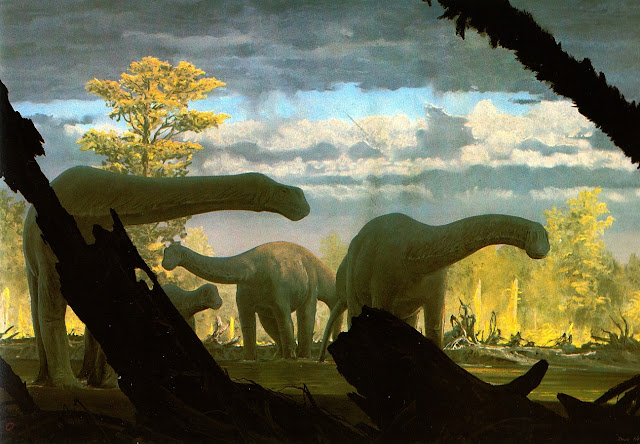That's right - it's time for another look at the best palaeoart of the 1980s, as presented in De Oerwereld van de Dinosauriërs, also known as Dinosaurs: a Global View. I'm sure all of you - literally all of you, every last individual reading this blog- eagerly lapped up the last installment, but I'll link you back to it as a formality. Onwards!
As usual, I've been forced to cut certain images up into chunks due to the small size of my scanner, so please take note that this is merely the right half of Hallett's stunning depiction of Dicraeosaurus. Out of all the artists working in the 1980s, it is perhaps Hallett's work that has best stood the test of time scientifically; with a few minor tweaks, many of his 1980s paintings would pass muster today. Of course, they are also artistic achievements to match the classic palaeoart greats, as evidenced upon closer examination of this image. One is so impressed by the majesty of these huge creatures, it's easy to miss such details as the 'waterlines' on their hides, and the beautifully rendered sky.
In the background, it's possible to see Hallett's experiments with sauropod posture (notice the individual on the left). It's a wonderful depiction of sauropods happily going about their business, and quite possibly my favourite spread in the entire book.
As I noted last time, Henderson's work serves as an effective contrast to Hallett's in the context of this book. Whereas Hallett's is more immediate and features the animals in sharp focus, Henderson often obscures them in shadow, vegetation, or both. One of his greatest strengths is in using light effectively to both draw the viewer into a scene, and invoke a strong emotional response. Here, the bunny-handed allosaurs may rudely stick out to the 21st-century dinosaur enthusiast, but it doesn't matter. We are invited to imagine this Diplodocus' story, and what might happen between it and the skulking predators. Unlike Hallett and others, Henderson rarely depicts a fight in mid-swing - rather, he is concerned with the before and after.
Of course, when all is said and done, what you really want is BLOOD - never mind all that artsy-fartsy nonsense. Proving that sauropods are perfectly capable of defending themselves, here we see Shunosaurus performing uninvited, impromptu dentistry on an allosaur (most likely Yangchuanosaurus). However, if you are quite sick of violent palaeoart, then you are invited to inspect the carefully considered anatomy of the animals and their beautifully detailed footprints. Everyone loves a footprint.
Again, as previously noted (whaddaya mean, I've run out of things to say?), Henderson's art frequently exhibits a melancholy that is vanishingly rare, if not unique in palaeoart. Here it is evoked by the jagged forms of the rotting trees in the foreground, the furious, stormy sky, and the fact that the sauropods kinda have sad faces. Don't they, though? I mean, it's enough to make you want to hug one of their massive scaly legs, or perhaps offer them a mug of hot chocolate with marshmallows and cream. They're Patagosaurus, by the way, an animal that resembled the more famous Cetiosaurus.
Even if you think you haven't seen Mark Hallett's Crossing the Flat before, you definitely have. It's a bona fide palaeoart classic; naturally, it is reproduced in the book as a double-page spread. As such, I can only present a detail here (the calf and the mother's neck - Mamenchisaurus was absurd), although I have featured the whole thing once before. It's the sort of painting that, should people ever ask you why you find dinosaurs so bloody fascinating, you can press their noses against and say simply "THIS".
The latest biomechanical work has revealed that Plateosaurus almost certainly wasn't ever a quadruped, but, again, that hardly tarnishes one's appreciation of this lovely scene. Although only the left half is shown here, it hopefully gives a suitable flavour of this typically Hendersonian work - a marvelously tranquil portrayal of a wandering herd. Once again, the viewer is placed in a realistically detached position, and in this case is even being addressed by a glancing plateosaur (or so it appears), which as in all of Henderson's work greatly enhances the feeling of wandering, alone, in the Mesozoic. You might not last that long, but at least you'd see something as glorious and moving as this before being shredded into little pieces by a mob of voracious Coelophysis.
I didn't feature any Sibbick last time. Admittedly, Sibbick's work is very much in the minority in this book, but nevertheless this should redress the balance. This particular piece - a ceratosaur shouting some obscene insults at some trumped-up brachiosaur - has featured in a number of different publications, among them The Ultimate Dinosaur Book, a favourite from my childhood. Many have questioned what, exactly, the horned one is hoping to achieve in facing such a vastly bigger adversary; indeed, the UDB noted that it was 'unlikely' that a puny ceratosaur would ever pick on an adult brachiosaur. However, one doesn't have to interpret the scene in this way - it could be that the ceratosaur has been disturbed by the brachiosaur's heffalumpian tramplings, and is giving the big lug a piece of its mind before reluctantly moving on. And if that doesn't convince you, just look at that pterosaur's face. Oh my, what a face.
Next week: something different! De Oerwereld van de Dinosauriërs will return, but variety is the nutmeg of existence, and all that. Perhaps some more Ely Kish, perhaps an obscure 1980s pop-up book...we'll see.









Sauropods for the win! Treated here by the very best, which is no less than they deserve, naturally.
ReplyDelete